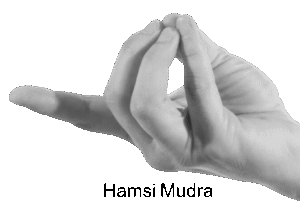Hamsi Mudra (Swan Gesture)
Introduction
Hamsi Mudra, also known as the Swan Gesture, is a yogic hand gesture that represents purity, spiritual elevation, and graceful energy flow. It is commonly practiced in meditation, pranayama, and yoga therapy to enhance mental clarity, calm the mind, and balance subtle energies.
The swan is considered a symbol of discernment, wisdom, and spiritual liberation in yogic philosophy, and Hamsi Mudra embodies these qualities.
Meaning
Etymology:
Hamsi derives from Hamsa, meaning swan in Sanskrit.
Mudra means gesture or seal.
Symbolism:
Represents purity of thought, spiritual discernment, and transcendence.
Encourages mental clarity, calmness, and spiritual insight.
Symbolically promotes the ability to differentiate between higher and lower energies, akin to a swan separating milk from water.
How to Perform Hamsi Mudra
Sit comfortably in a meditation posture (Sukhasana, Padmasana, or Vajrasana) with a straight spine.
Join the tips of the middle, ring, and little fingers with the tip of the thumb. Extend the index finger.
Close your eyes and focus on slow, deep breathing, visualizing purity and wisdom flowing through your body and mind.
Maintain this mudra for 10–20 minutes, ideally during meditation or pranayama.
Tip: Practicing in a serene environment enhances mental and spiritual benefits.
Benefits
Enhances mental clarity, focus, and concentration.
Promotes spiritual awareness, discernment, and inner calm.
Reduces stress, anxiety, and mental fatigue.
Supports energy flow and balance in the body and subtle channels.
Encourages mindfulness and meditative depth.
Strengthens mind-body coordination and sensory awareness.
Contraindications
Avoid if there is pain, injury, or inflammation in fingers, hands, or wrists.
People with arthritis or joint limitations should practice gently or modify finger placement.
Discontinue if discomfort occurs during practice.
Anatomy & Physiology
Involves phalanges, interphalangeal joints, intrinsic hand muscles, and forearm muscles.
Stimulates median and ulnar nerve endings, enhancing sensory perception and cortical activity.
Improves circulation in hands and forearms, indirectly supporting nervous system balance.
Promotes relaxation in shoulders, chest, and upper back, facilitating deeper breathing and prana flow.
Kinesiology
Isometric contraction of thenar, hypothenar, and interossei muscles maintains finger configuration.
Engages forearm and shoulder muscles for stability.
Enhances fine motor control, proprioception, and hand awareness.
Supports mind-body integration through intentional hand placement and meditative focus.
Neurology
Activates median, ulnar, and radial nerves, stimulating somatosensory and motor cortices.
Promotes parasympathetic nervous system activation, reducing stress and enhancing calmness.
Visualization of the swan strengthens neural pathways associated with mental clarity, discernment, and spiritual awareness.
Duration of Practice
Beginners: 5–10 minutes daily.
Intermediate/Advanced: 10–20 minutes, once or twice daily.
Can be combined with meditation, pranayama, or mindfulness practices.
Counter Mudra
Gnana Mudra or Prana Mudra can serve as counter mudras to energize and balance subtle energies after Hamsi Mudra practice.
Alternating Hamsi Mudra with these mudras balances mental calmness with energy activation.
Conclusion
Hamsi Mudra is a powerful gesture for mental clarity, spiritual discernment, and calm awareness. Regular practice enhances focus, mindfulness, spiritual insight, and subtle energy balance, making it a valuable tool in meditation, pranayama, and yoga therapy.
FAQ
Q1: Can Hamsi Mudra improve focus and meditation?
A1: Yes, it enhances concentration, clarity, and meditative depth.
Q2: Can children practice it?
A2: Yes, with guidance and gentle hand placement.
Q3: Is visualization necessary?
A3: Visualization enhances benefits, but mindful finger placement and deep breathing are sufficient.
Q4: Can it be combined with other mudras?
A4: Yes, especially with meditation, pranayama, or other energy-balancing mudras.
References
Swami Satyananda Saraswati, Mudras for Healing and Transformation, Bihar Yoga Publications, 2012.
Dr. Harish Johari, Mudra: The Gateway to Health, Inner Traditions, 1994.
B.K.S. Iyengar, Light on Yoga, HarperCollins, 2005.
Yoga Journal, Mudras for Mental Clarity and Spiritual Awareness, 2018.
Hatha Yoga Pradipika and yogic texts on energy channels, prana flow, and meditation practices.
